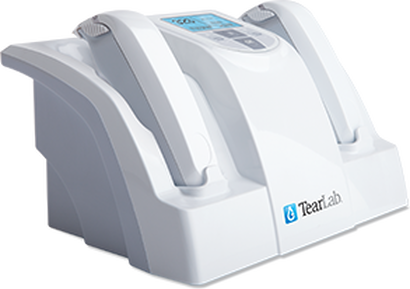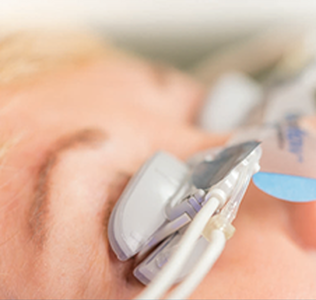Dry Eye Center
Optimize your tear film disrupted by ocular surface disease

Ocular surface disease (OSD), or most commonly known as dry eye, is a condition in which a person doesn’t have enough quality tears to lubricate and nourish the eye. Ocular surface disease is a common and often chronic problem. Tears are necessary for maintaining the health of the front surface of the eye and for providing clear vision.
A large segment of the population suffers from dry eye symptoms. We use advanced technology to diagnose, determine the cause of, and provide treatment for dry eye symptoms.
Ocular surface disease symptoms include tired, red, burning, scratchy or watery eyes.
People with ocular surface disease either do not produce and maintain enough tears, or their tears are of poor quality. Examples of tear film deficiency include:
- Inadequate amount of tears. Tears are produced by several glands in and around the eyelids. Tear production tends to diminish with age, various medical conditions, or as a side effect of certain medicines and eye surgeries. Wind and dry climates can also decrease tear volume due to tear evaporation. When the normal amount of tear production decreases or tears evaporate too quickly from the eyes, symptoms of dry eye can develop.
- Poor quality of tears. Tears are made up of three layers: oil, water, and mucus. Each component protects and nourishes the front surface of the eye. A smooth oil layer helps prevent evaporation of the water layer, while the mucin layer spreads the tears evenly over the surface of the eye. If tears evaporate too quickly or do not spread evenly over the surface of the eye due to deficiencies with any of the three tear layers, dry eye symptoms can develop.
- Infrequent blinking, as a result of excessive use of modern display technologies, such as computer monitors and device screens, creates a demand for more lubrication on the eye, stimulating more oil production. Over time, this can lead to thickening of the oil, blockage of the meibomian glands that produce the oil, and shutdown of oil production in the meibomian gland.
Diagnosing Ocular Surface Disease
Ocular Surface Disease is diagnosed through a comprehensive eye examination. Our doctors evaluate information obtained from advanced diagnostic technology, including TearLab® and LipiView® to determine if dry eye is present and its causes.

TearLab®
TearLab provides information about tear composition to help diagnose the severity of dry eye and to manage patient progress with treatments.
A leading cause of dry eye symptoms is Meibomian Gland Dysfunction (MGD), a condition that occurs when the protective lipid (oil) that normally flows from meibomian glands in the eyelid is slowed or stopped due to blockage in the glands.

LipiView II®
LipiView II with Dynamic Meibomian Imaging ™ is the only instrument available that assesses both meibomian gland function and structure to detect MGD in its earliest stages. It accurately measures oil layer thickness, evaluates blink rate, and visualizes the meibomian gland structure.
Treating Ocular Surface Disease
The treatment of OSD symptoms is tailored to their cause. Primary approaches include adding tears using over-the-counter artificial tear solutions, conserving tears, increasing tear production, and treating the eyelids, meibomian gland blockage, or the eye surface inflammation that contributes to the dry eye. Blink training is prescribed for patients who only partially blink.
Ocular lubricants are used to provide temporary relief of dry eye symptoms by adding fluid to the eye.
Medications prescribed for OSD are typically used to alleviate patient symptoms and also may be used to reduce inflammation, as needed.
Punctal plugs are painlessly inserted into the tear ducts to block the outflow of tears. The goal is to hold the tears on the eye.
Eyelid scrubs are used to remove debris from the eyelashes and the lid margins. Lid hygiene is key to maintaining health of the meibomian glands and surface of the eye. Similar to good oral hygiene for keeping teeth clean and healthy, good lid hygiene helps reduce eyelid inflammation and requires that both the lashes and lid margins be cleaned regularly.
Warm/hot compresses, applied daily, can help unclog blocked meibomian glands by heating the eyelids from the front surface. However, it is difficult to achieve and sustain the level of heat needed to treat MGD using front surface heating. Compliance with daily use of compresses is an essential part of this therapy.
Omega-3 Fish Oils help suppress systemic inflammation, which contributes to dry eye symptoms. Dietary supplements containing Omega-3 oils may help decrease dry eye symptoms in some patients.
Blink training and exercises are prescribed for patients who only partially blink. Complete blinking is required to fully express the oil from the meibomian glands and to keep the glands from becoming blocked.

Treating Meibomian Gland Dysfunction
LipiFlow® is the only in-office, FDA-approved device to treat MGD.
With precise heat and pulsation, it unblocks meibomian glands, allowing them to resume the natural production of oil needed for healthy tears.
